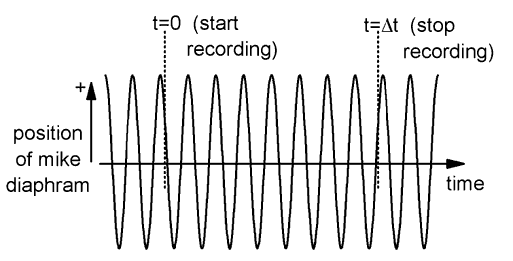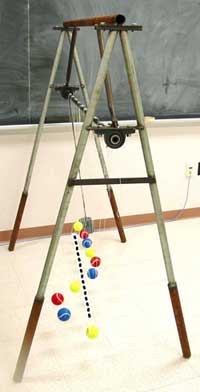Experiment of The Month
A Musical Uncertainty Principle
If we record a tone with frequency f for a period of 

In the figure, we would count seven peaks during the interval  so the frequency would be
so the frequency would be 
 happens to be 1 second, then the frequency is
happens to be 1 second, then the frequency is
 .
.
If we had started or ended 

It is fair to say that our value for the frequency is uncertain, and the size of the uncertainty is 
 and drop the word "cycle" to get
and drop the word "cycle" to get
Physicists call this sort of equation an "uncertainty principle." We are interested in it because it applies in a variety of places, meaning (for example) that if you measure the energy of a particle for a short time then you cannot have an accurate result for the energy (no matter how good your instruments are).
The longer you spend measuring the frequency, the smaller is your uncertainty. (The idea is that you are always uncertain by about 1 cycle, but this doesn't make much difference if you counted a lot of cycles - just as a dollar difference in price is important for a hamburger but not for a car.)
In many things, like a pendulum, the vibration dies away soon after you stop adding energy. (Think of playing 

For a solid iron 
Using a formula for the frequency of a pendulum, this corresponds to an uncertainty of about 1cm in the

In the figure from past experiment 80, the four tennis balls that respond most strongly to the heavy driver pendulum vary in length by about 1cm, from the longest to the shortest. In an ideal case, the only pendulum that would respond to the driver would be the one with exactly the same length. That is it would be nearly impossible to construct a pendulum that would respond.
Because there is uncertainty in the frequency of the tennis ball pendulum, the driver is able to drive a tennis ball of the "wrong" length. Essentially, the tennis ball "forgets" what it was doing 200 seconds ago, so even if the driver was "out of step" then, the fact is forgotten, and the tennis ball accepts energy from the driver.
Because it "forgets", the tennis ball swings in sympathy with the current driver oscillation, at the current driver frequency.
The uncertainty in the frequency is often called the width of the oscillating object. A driver with a frequency with the range defined by the width will successfully
In quantum mechanics, the frequency is connected to the energy of an object, and the same relation predicts that an object can have a very large (comparable to its rest energy mc2) for a time interval of very short duration. It is for this reason that empty space is said to be "frothy" over short time intervals.
-
Contact Information
Contact Number: 717-871-4297
Email: physics@millersville.edu